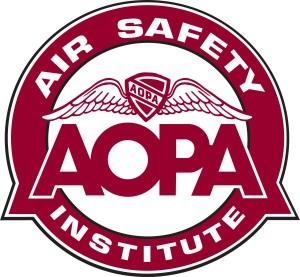Tue, Aug 25, 2015
The AOPA Air Safety Institute Has Issued A Safety Alert Regarding Midair Collision Avoidance
The Air Safety Institute Alert is of particular importance to recreational flyers because we fly at so many nontowered airports and most of our aircraft do not have collision avoidance systems installed. The alert message published by the Safety Institute repeats things we should already know, but it’s always good to review the basics.

The alert message says that although the frequency of midair collisions has seen a decrease over the past few years, there have been five in the past year that have resulted in loss of life. Last fall, an amateur-built Searey collided with a Cessna 172 in upstate New York, a Cessna 170 and a Skykits-Savannah collided in Nevada, and a Cirrus SR22 collided with a Robinson R22 helicopter in Maryland
This summer, a Cessna 150 and an F-16 collided in SC and, most recently, a Cessna 172 and a Sabreliner jet collided near San Diego, CA. While each accident has a specific set of circumstances and the NTSB is in the process of investigating, there are steps pilots can take to minimize the risks.
The following is a brief outline of things to be aware of and to watch out for:
- See and avoid continues to be the foundation for flying under visual flight rules. Pilots must be extra vigilant and constantly scan the airspace for traffic.
- Always fly on a designated VFR cruise altitude: Easterly–odd thousands plus 500 feet; Westerly–even thousands plus 500 feet.
- Request ATC’s VFR flight following service to the maximum extent possible.
- If your aircraft is equipped, ensure the transponder is always on to increase your aircraft’s electronic visibility.
- Consider equipping with ADS-B (both Out and In) so you can benefit from the increased situational awareness available with the Traffic Information Service-Broadcast (TIS-B).
- Consider installing an active traffic system or carry a portable traffic awareness product.
More than 50 percent of all midair collisions happen within 5nm of an airport—extra vigilance is required in the terminal area. The following are suggestions for increasing safety in this elevated area:
- At towered airports monitor the frequency and communicate early with the tower to gain situational awareness.
- At nontowered airports, broadcast your position and intentions no later than 10nm from the airport. Follow standard traffic pattern entry procedures, and broadcast your position and intentions on the common traffic advisory frequency in accordance with Section 4-1-9 of the Aeronautical Information Manual.
- Ensure aircraft landing lights, position lights, and anti-collision lights are on in the terminal area for maximum visibility.
- If carrying passengers, involve them in your traffic awareness process.
Midair collisions happen infrequently; however, when they occur, the chances for injury or death are substantial. To learn more about midair collision avoidance and to increase your safety margins, see the Air Safety Institute’s Collision Avoidance Spotlight at the link listed below.
More News
Airport Rotating Beacon A visual NAVAID operated at many airports. At civil airports, alternating white and green flashes indicate the location of the airport. At military airports>[...]
Aero Linx: Fly for the Culture Fly For the Culture, Inc. is a 501(c)(3) non-profit organization that serves young people interested in pursuing professions in the aviation industry>[...]
Klyde Is Having Some Issues Comprehending The Fed's Priorities FMI: www.klydemorris.com>[...]
Also: Viasat-uAvionix, UL94 Fuel Investigation, AF Materiel Command, NTSB Safety Alert Norges Luftsportforbund chose Aura Aero's little 2-seater in electric trim for their next gli>[...]
Also: EP Systems' Battery, Boeing SAF, Repeat TBM 960 Order, Japan Coast Guard H225 Buy Despite nearly 100 complaints totaling millions of dollars of potential fraud, combined with>[...]
 ANN's Daily Aero-Term (04.25.24): Airport Rotating Beacon
ANN's Daily Aero-Term (04.25.24): Airport Rotating Beacon ANN's Daily Aero-Linx (04.25.24)
ANN's Daily Aero-Linx (04.25.24) Klyde Morris (04.22.24)
Klyde Morris (04.22.24) Airborne 04.24.24: INTEGRAL E, Elixir USA, M700 RVSM
Airborne 04.24.24: INTEGRAL E, Elixir USA, M700 RVSM Airborne 04.22.24: Rotor X Worsens, Airport Fees 4 FNB?, USMC Drone Pilot
Airborne 04.22.24: Rotor X Worsens, Airport Fees 4 FNB?, USMC Drone Pilot



